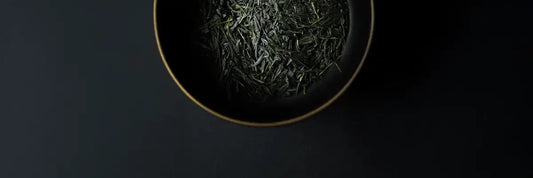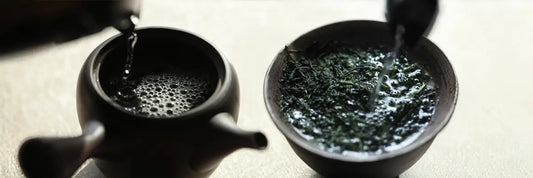Gyokuro caffeine levels are some of the highest in the world of tea. In this article, we are going to learn why the caffeine in gyokuro is so high and also how much caffeine is in gyokuro green tea compared to other teas.
Finally, we’ll show you how you can influence the gyokuro caffeine amount just through the selection and brewing of the tea.
Let’s get started! ☕️
How Much Caffeine is in Gyokuro Tea?
Why Does Gyokuro Have Caffeine

So why does gyokuro have caffeine? It has to do with how the gyokuro plant defends itself against insects. The tea plant naturally produces caffeine on the outer layer of the tea leaf in order to protect itself from insects. Caffeine can be very bitter, or even poisonous to small insects, so it makes for good protection.
Ironically, this caffeine content in the tea plant has made it more desirable for humans. The first people to drink tea in Japan were the monks, who found that it enhanced their concentration during long periods of meditation.
The Science Behind Gyokuro Tea Caffeine
We now know that this was due to the combination of caffeine and L-theanine. Caffeine is a stimulant, but L-theanine can actually slow the absorption of caffeine and induce a calming effect on the brain. These two work in synergy to give you a calm, alert feeling that lasts throughout the day. Even though the gyokuro green tea caffeine is high, so is the L-theanine. That’s why you won’t get the crash or the jitters you normally associate with caffeinated drinks like coffee.
Why Is the Gyokuro Tea Caffeine Level So High?
The reason that gyokuro caffeine content is particularly high has to do with how the tea is grown and harvested.
To be considered a gyokuro, the tea plant needs to be shaded for 3 weeks or more prior to the harvest.
During this time, the tea plant is cut off from sunlight with a special type of netting called kabuse.
The reason this is done is because it stops the tea plant from producing bitter catechins and allows it to maintain sweet and savory theanine. It also increases the caffeine in gyokuro.
The shading process can be a stressful time for the tea plant. It produces more caffeine to protect its leaves from insects. This is why if you’re looking for a tea that is high in caffeine gyokuro and other shaded Japanese green teas can be a great option.
How Picking Affects the Gyokuro Caffeine Content
The caffeine in gyokuro green tea is also affected by how the tea is picked. The farmer selects the top 3 sprouts of the tea plant, as these are the sweetest and smoothest in flavor. These tea leaves also contain the highest caffeine content.
The younger sprouts of the tea plant are more tender and vulnerable to insects. In response, the tea plant produces more caffeine in order to protect them. This is why teas made from younger leaves have a higher caffeine content than teas made from the tougher mature leaves and stems of the tea plant.
Because of the shading and the harvesting process, the gyokuro tea caffeine content is among the highest in the world of tea!
Gyokuro Imperial Green Tea Caffeine Content
The reason gyokuro is known as the imperial green tea is because it was once the tea of choice for the emperor. Before the widespread use of refrigeration, the quality of a tea was assessed by how well it maintained its flavor with age. The emperor would often wait a while after the harvest before evaluating the tea.
Because gyokuro tea is maintained or even improved by age, this was always the tea the emperor selected for his private collection. Gyokuro producers still compete around Japan to be the tea of choice for the emperor.
So this is why gyokuro tea is called imperial green tea, and if you are looking for the gyokuro imperial caffeine content, this is the same thing as regular gyokuro green tea, just under a catchy name.
How Much Caffeine Is in Gyokuro Green Tea
Finally, let’s talk about how much caffeine is in gyokuro green tea. The answer is between 120–140mg of caffeine, but this can depend on a few different factors. Let’s cover how the gyokuro green tea caffeine content can change based on cultivar, gyokuro brewing method and gyokuro brewing temperature.
Cultivar
The gyokuro tea caffeine can depend on the variety of tea plant being used to make it. For example, the Saemidori Gyokuro Cha Mejin will have a higher caffeine content compared to the Yabukita Gyokuro Cha Musume. This will only have a slight impact, but the impact is there nonetheless.
Brewing
The gyokuro tea caffeine level can also depend on how the tea is brewed. What some tea masters will do is brew the tea with 5 grams of leaves and only 50ml of water. This really concentrates the flavor and health gyokuro tea benefits into a smaller space, but it also creates a high caffeine gyokuro.
Temperature
The final factor that can influence gyokuro green tea caffeine content is the temperature you use to brew the tea. Caffeine is one of the chemical compounds in tea that is extracted at a higher temperature, so the lower you go with the water temperature, the less caffeine you will extract.
If you’re looking for a low caffeine gyokuro, you can cold brew gyokuro. This will not only create a cool, refreshing cup of green tea, but it will also lower the caffeine content. This is perfect because when you first taste cold brewed gyokuro, you will want to drink it all throughout the afternoon!
Final Thoughts on the Caffeine in Gyokuro

While the amount of gyokuro caffeine can vary greatly based on how the tea is produced and prepared, it tends to be a very high-caffeine tea.
You should avoid this tea if you are sensitive to caffeine, but if you are looking for a replacement for coffee, the gyokuro tea caffeine content can be just what you’re looking for!
After traveling around Japan for the past couple of years, we have met with dozens of farmers and sampled many different gyokuro teas.
The best gyokuro we’ve found are produced by Mr. Sakamoto, a talented farmer in the town of Shibushi.





1 comment
Great article.